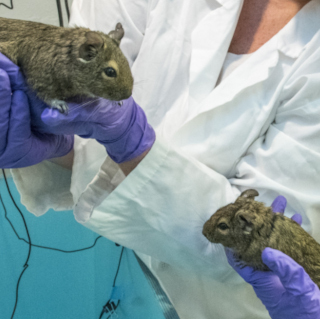Borrelia burgdorferi
Last Review Date: November 1, 2022
Introduction
Borrelia burgdorferi is the causative agent of Lyme disease. B. burgdorferi is classified as a Risk Group 2 bacterial agent (NIH Guidelines Appendix B-II-A) and is handled at BSL-2 and ABSL-2 conditions. To date, there has never been a reported case of laboratory-acquired infection.
Safety Procedures in the Animal Facility
Biohazard signs are to be posted on the entry door to HSB 004 and on the cubicle where the mice are housed and work is conducted. All personnel will wear a dedicated lab coat (located within the housing cubicle) and gloves when working with animals. An active B. burgdorferi infection is present in the animal for 5 weeks following inoculation.
A. A cage with a mesh-wire bottom is placed above a pan filled with water and will
house one mouse while ticks are allowed to feed.
B. The pan and cage are placed into a larger rat cage with the bottom filled with
water. A barrier of petroleum jelly and double-sticky-sided tape is placed around the
inside of the top of the rat cage.
C. In addition to the layers of double-sided tape and petroleum jelly around the cages,
strips of sticky mat are placed around the door of the cubicle to provide a second
layer of security. The PI's research personnel will provide food and water to the mice
during tick feeding.
D. If a tick is found loose in HSB 004, collect the tick in a tightly sealed container
(e.g., screw cap plastic tube, vial, zip-lock bag) and contact the PI or his research
personnel.
E. All ticks will be collected at the end of the experiments and placed in a screw-top
conical tube and autoclaved.
F. All cages and equipment that have come in contact with the infected ticks will be
autoclaved.
G. Mice infested with ticks will be euthanized and the carcass autoclaved using the
same procedures described above.
Accidental Spill or Exposure
Protective clothing including laboratory coats and gloves must be worn. All spills of live cultures will be gently covered with paper towels and then treated with bleach (1% sodium hypochlorite) or Peroxigard RTU starting at the perimeter and working towards the center of the spill. Contact time of the bleach/Peroxigard is at least 15 minutes. Paper towels will then be collected into biohazard bags, sealed, and steam sterilized in an autoclave. Biohazard markings on the bag will be defaced following sterilization.
The incidental transmission of B. burgdorferi to humans in the laboratory resulting in Lyme disease has never been reported. Currently, there is no human vaccine available. Transmission by aerosol inhalation, ingestion, or skin-to-skin contact has also never been reported and is unlikely. However, in the event of such a laboratory-acquired infection, treatment of Lyme disease is by antibiotic therapy based on guidelines from the Infectious Diseases Society of America (IDSA): "For prevention of Lyme disease after a recognized tick bite…. A single dose of Doxycycline may be offered to adult patients (200 mg dose)…when all of the following circumstances exist: (a) the…tick…is estimated to have been attached for >36 h on the basis of the degree of engorgement of the tick with blood or of certainty about the time of exposure to the tick; (b) prophylaxis can be started within 72 h of the time that the tick was removed;…[and] (c)…doxycycline treatment is not contraindicated." Otherwise: "Doxycycline (100 mg twice per day), Amoxicillin (500 mg 3 times per day), or Cefuroxime Axetil (500 mg twice per day) for 14 days (range, 10–21 days for Doxycycline and 14–21 days for Amoxicillin or Cefuroxime Axetil) is recommended for the treatment of adult patients with early localized or early disseminated Lyme disease….Patients who are intolerant of, or should not take, Amoxicillin, Doxycycline, and Cefuroxime Axetil…the recommended dosage regimens for macrolide antibiotics are as follows: Azithromycin, 500 mg orally per day for 7–10 days; Clarithromycin, 500 mg orally twice per day for 14–21 days (if the patient is not pregnant); or Erythromycin, 500 mg orally 4 times per day for 14–21 days" (Wormser et al., 2006, The clinical assessment, treatment, and prevention of Lyme disease, human granulocytic anaplasmosis, and babesiosis: clinical practice guidelines by the Infectious Diseases Society of America, Clin. Infect. Dis. 43:1089-1134). The Occupational Health physician at Curry HS may be contacted to write the prescription for antibiotics.
